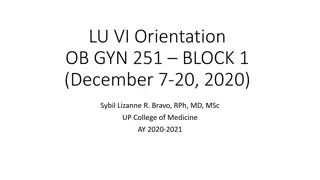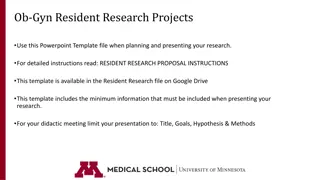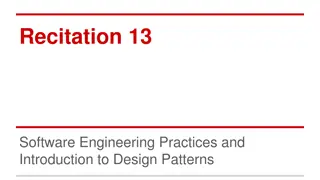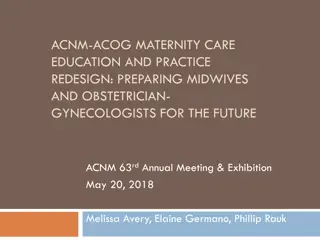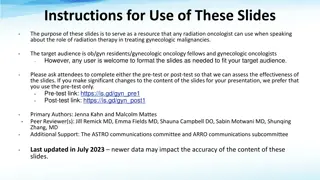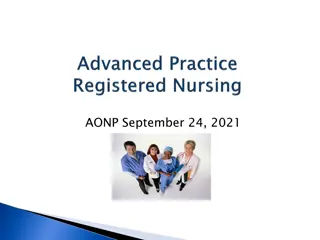Midwife and OB-GYN Role Clarity in Team-based Practice
Understanding the distinct roles and credentials of midwives (CNMs/CMs) and obstetrician/gynecologists (Ob-gyns) is crucial for effective team-based care in women's health. This article delves into the educational pathways, scopes of practice, collaborative patterns, and values of these healthcare providers, highlighting areas of overlap and differences for respectful and patient-centered care.
Download Presentation

Please find below an Image/Link to download the presentation.
The content on the website is provided AS IS for your information and personal use only. It may not be sold, licensed, or shared on other websites without obtaining consent from the author. Download presentation by click this link. If you encounter any issues during the download, it is possible that the publisher has removed the file from their server.
E N D
Presentation Transcript
Midwife and Ob-gyn Role Clarity for Team-based Practice Melissa D. Avery, PhD, CNM, FACNM, FAAN Phillip N. Rauk, MD, FACOG
Learning Objectives 1. Identify the educational pathways and credentialing of midwives (CNMs/CMs) and Ob-gyns. 2. Identify the scope and values of midwives and Ob- gyns, including areas of overlap and differences. 3. Describe patterns of collaborative practice including appropriate use of language in partnering together and with patients in respectful team-based care.
Formal Definitions/Credentials Obstetrician/Gynecologist (Ob-gyn) Medical doctor (MD) allopathic medicine, treats disease symptoms using remedies such as drugs or surgery Doctor of osteopathic medicine (DO) strong focus on alternative therapies, holistic medicine, and disease prevention Piedmont Healthcare. (n.d.) Your doctor: The difference between an M.D. and D.O. Retrieved from https://www.piedmont.org/living-better/your-doctor-the-difference-between-an-md-and-do UCLA David Geffen School of Medicine. (2017). DO vs. MD: What s the difference? Retrieved from http://medschool.ucla.edu/body.cfm?id=1158&action=detail&ref=1019
Formal Definitions/Credentials Certified Nurse-Midwife (CNM) Registered nurse, completion of Accreditation Commission for Midwifery Education (ACME)-accredited graduate midwifery program, national certification by American Midwifery Certification Board (AMCB) Advanced practice registered nurse (APRN) license in many states Authorized to practice and prescribe in all U.S. states and territories Certified Midwife (CM) Completion of ACME-accredited graduate midwifery program, national certification by AMCB (registered nurse not required) Authorized to practice in 5 states Certified Professional Midwife (CPM) No specific degree required or granted upon completion, certification by North American Registry of Midwives (NARM) Apprenticeship education process; some programs accredited by Midwifery Education and Accreditation Council (MEAC) Work outside of hospital setting, authorized to practice in 32 states American College of Nurse-Midwives. (2017). Comparison of certified nurse-midwives, certified midwives, certified professional midwives clarifying the distinctions among professional midwifery credentials in the U.S. Retrieved from http://www.midwife.org/acnm/files/ccLibraryFiles/FILENAME/000000006807/FINAL-ComparisonChart-Oct2017.pdf
What is a CNM/CM? Primary care provider from adolescence to beyond menopause Provides primary care, gynecologic and family planning services, preconception care, care during pregnancy, childbirth, postpartum, normal newborn for first 28 days of life, treatment of male partners for sexually transmitted infections Educated in discipline of midwifery, CNMs also educated in discipline of nursing
What Services are Provided by Midwives? General health care services Family planning needs Annual gynecologic exams Care during adolescent years Treatment of sexually transmitted infections Care for pregnancy, labor, birth and postpartum Menopause care
Midwifery Scope of Practice Most CNMs/CMs identify reproductive and primary care as main responsibilities Initial, ongoing comprehensive assessment, diagnosis, and treatment Annual physical examinations, reproductive health visits Prescribe medications including controlled substances and contraceptive methods Admit, manage, and discharge patients Order and interpret laboratory, diagnostic tests, medical devices Individualized prevention, wellness counseling and patient education Scope varies somewhat by state, some states require MD supervision Practice in ambulatory care clinics, private offices, community and public health systems, homes, hospitals, and birth centers American College of Nurse-Midwives. (2004). Definition of midwifery and scope of practice of certified nurse-midwives and certified midwives. Retrieved from http://www.midwife.org/ACNM/files/ACNMLibraryData/UPLOADFILENAME/000000000266/Definition%20of%20Midwifery%20and%20Scope%20of%20Practice%20of%20CN Ms%20and%20CMs%20Dec%202011.pdf
What is an Ob-gyn? A physician who has graduated from an accredited residency program who commits their career to comprehensive women s health including gynecology and obstetrics, medically and surgically Serve as consultant to other physicians and as primary physicians for women Subspecialties: maternal-fetal medicine, reproductive endocrinology and infertility, gynecology/oncology, family planning, female pelvic floor and reconstructive surgery Vogt, V.Y. (n.d.) Obstetrics and gynecology. American College of Surgeons. Retrieved from https://www.facs.org/education/resources/residency-search/specialties/obgyn
Ob-gyn Scope of Practice Ob-gyns are dedicated to medical and surgical care of women throughout their lifespan May choose a focused area of specialization, e.g. Fellowship in Gynecologic Oncology, Maternal Fetal Medicine, etc. Gynecology Reproductive physiology including factors that influence disease Gender-specific prevention counseling and health education Gynecologic surgery - Vulva, vagina, cervix, uterus, tubes, ovaries, pelvic floor (NOT bladder, kidney, GI tract) Obstetrics Antepartum, intrapartum, and postpartum care Patient education and advocacy American Congress of Obstetricians and Gynecologists. (2005). The scope of practice of obstetrics and gynecology. Retrieved from https://www.acog.org/About-ACOG/Scope-of-Practice
What do we care about? Ob-gyn: Core Values of the American College of Obstetricians and Gynecologists Believe all women should have access to high quality safe health care. We promote best practices in women s health care through research and education. We advocate for women and the specialty; provide women s health information to patients, providers, organizations and governments. Midwifery: Philosophy of the American College of Nurse- Midwives Believe in the strength of women and the importance of their health in the well-being of families, communities and nations. We believe in the basic human rights of all persons, recognizing that women often incur an undue burden of risk when these rights are violated. American College of Nurse-Midwives. (2004). Philosophy of the American College of Nurse- Midwives. Retrieved from http://www.midwife.org/ACNM/files/ccLibraryFiles/Filename/000000002729/Philosophy%20of%2 0ACNM%209%202004.pdf American Congress of Obstetricians and Gynecologists. (n.d.). ACOG mission, vision and core values. Retrieved from https://www.acog.org/About-ACOG/About-Us/ACOG-Mission-Vision-and-Core- Values
Formal Education Structures CNM/CM 4 years, nursing major for CNMs Master s (2 years) or Doctoral (3 years) midwifery program required for certification Includes clinical experience OB/GYN 4 years any major (must include sciences) 4 years allopathic or osteopathic medical education (medical school) Undergraduate Program Graduate Program 4 years ACGME or DO approved residency program Accreditation Council for Graduate Medical Education (ACGME) Additional Training Accreditation Commission for Midwifery Education (ACME) Accreditation
Physicians: Path to Ob/gyn License to practice (limited license may be obtained earlier American Board of Obstetrics & Gynecology College or Post-Bacc Program Residency in Ob/Gyn (4 years) Medical School (MD or DO 4 years) Obtain a Bachelor's Degree with pre-reqs
Physicians: Path to Ob/gyn License to practice (limited license may be obtained earlier College or Post-Bacc Program American Board of Obstetrics & Gynecology Residency in Ob/Gyn (4 years) Medical School (MD or DO 4 years) Obtain a Bachelor's Degree with pre-reqs
Physicians: Path to Maternal Fetal Medicine Fellowship in MFM (3 years) License to practice American Board of Obstetrics & Gynecology Residency in Ob/Gyn (4 years) Medical School (MD or DO 4 years) Obtain a Bachelor's Degree with pre- requistes
Perinatology Obstetrical management of high-risk pregnancy Specializing in the un-routine MFM Scope of Practice
Certified Nurse-Midwives/Certified Midwives +/- Work as an RN, experience in other maternal/child related fields Obtain a Bachelor's Degree and an RN or a BSN. Complete an Accreditation Commission of Midwifery Education accredited program, earning a graduate degree American Midwifery Certification Board Exam License to practice as CNM/CM* Programs exist to bridge directly to midwifery education program Direct entry program to certified midwifery without nursing *CM credential recognized in DE, ME, MO, NJ, NY, RI, HI
Certified nurse-midwives are registered nurses who have graduated from a nurse-midwifery education program accredited by the Accreditation Commission for Midwifery Education (ACME) and have passed a national certification examination to receive the professional designation of certified nurse-midwife. Certified midwives meet the same midwifery education and certification standards as CNMs, but come from a non-nursing background in healthcare. CMs are certified by the same mechanism as CNMs. Licensed in states where the credential is recognized: DE, NJ, ME, NY, RI, HI. Certified Professional Midwivesare direct entry midwives without a nursing background. They do not go through the same master s level education. Training is variable, and licensing is voluntary, not required, in some states. They take a different national certification exam from CNMs/CMs. Types of Midwifery
Comparison of CNM/CM vs CPM CNM/CM CPM Accreditation Commission for Midwifery Education (ACME) American Midwifery Certification Board (AMCB) American College of Nurse-Midwives (ACNM) Midwifery Education Accreditation Council Education accreditation North American Registry of Midwives (NARM) National Association of Certified Professional Midwives (NACPM) Practice authority in 32 states Certification Professional Organization CNMs All 50 states, DC and US Territories CMs 5 states (DE, ME, NJ, NY, RI) CNMs All 50 states, DC and US Territories CMs ME, NJ, DE, NY, RI, HI Hospital, birth center, home Licensure None Authorization to Prescribe Home, birth center Practice sites
Traditional Midwives Midwives who for religious, personal, and philosophical reasons choose not to become certified or licensed are typically referred to as Traditional Midwives Beliefs include: midwifery is a social contract between the midwife and client/patient women have a right to choose qualified care providers regardless of their legal status midwives are ultimately accountable to the communities they serve midwifery should not be legislated at all
Midwifery Competencies Hallmarks of Midwifery person-centered, continuity, prevention, cultural humility, respects diverse backgrounds and identities, shared decision making, human presence, evidence-based care Professional Responsibilities national and international trends in women s health, transgender and perinatal care, support related legislation and policy, bioethics, life-long learning, practice management knowledge, support profession, participate in midwifery education Midwifery Management Process ongoing assessment of client situation, care planning and evaluation, care partnership with clients, collaboration with others as needed Fundamentals including physiology and pathophysiology, growth and development, psychosocial development, nutrition, pharmacotherapeutics, bioethics, genetics/genomics Components of Midwifery Care primary, preconception, gynecologic, antepartum, intrapartum, postpartum care; normal and deviations, national care objectives, collaboration and referrals as needed Components of Midwifery Care of the Newborn transition to extrauterine life, family transition, feeding, care for first 28 days of life I. II. III. IV. V. VI.
Ob-gyn Competencies I. Basic science concepts reproductive anatomy & physiology, genetics, and infectious disease Obstetrics antepartum, intrapartum, and postpartum care and related procedures including deliveries (vaginal, cesarean, operative) and laceration repair III. Gynecology disorders of reproduction and related procedures including hysterectomies and other surgeries IV. Office visits periodic assessments and standard care V. Professional competencies patient care, medical knowledge, communication, professionalism, systems-based practice, and practice-based care II.
Overlapping Practice Areas ObGyn/MFM: Higher Risk Patients Moderate Risk Patients Midwifery: Lower Risk Patients Physician-Led Jointly-Led Midwife-Led Ob-gyns and CNMs/CMs are experts in their respective fields of practice and are educated, trained, and licensed independent clinicians who collaborate depending on the needs of their patients. Quality of care is enhanced by collegial relationships characterized by mutual respect and trust; professional responsibility and accountability; and national uniformity in full practice authority and licensure across all states. Joint Statement of Practice Relations Between Obstetrician/Gynecologists and Certified Nurse-Midwives/Certified Midwives
Teamwork What is a team? Two or more people whose tasks are in some way interdependent (i.e. individual efforts are dependent upon the efforts of other members) and who have shared, common goals. Why is teamwork important? Better patient outcomes Better working environment Higher professional satisfaction Salas, E. (2015). Team training essentials: A research-based guide. New York: Routledge
The Core Team Team leaders, members directly involved in patient care Example of activities: Labor and delivery management and support Emergency response Antenatal and postnatal care Keys for success: A clear leader that is defined by clinical scenario Designated roles and responsibilities with shared mental model Situation monitoring/mutual support Clear communication Adaptability Agency for Healthcare Research and Quality. (2017). TeamSTEPPS: Team strategies & tools to enhance performance & patient safety. Retrieved from https://www.ahrq.gov/teamstepps/index.html
Why Collaborate? Common overlapping areas of practice Situations where the expertise of one may lead to collaboration with the other Consultation and/or referrals back and forth Jointly managing women s care due to provider or patient request Includes mutual respect, trust between providers, system that promotes team care
Collaborative Care The Hallmarks of Midwifery: "Ability to collaborate with and refer to other members of the interprofessional health care team Right providers work in partnership with patients and their families for highest quality evidence-based care that meets their needs ACOG: Implementing Team-Based Care Meeting the needs of the patient while maximizing the expertise of the health care providers on the team Practice to the best of your ability and in the best interest of the patient Continuous professional development is essential American College of Nurse-Midwives. (2012). Core competencies for basic midwifery practice. Retrieved from http://www.midwife.org/ACNM/files/ACNMLibraryData/UPLOADFILENAME/000000000050/Core%20Comptencies%20Dec%202012.pdf American Congress of Obstetricians and Gynecologists. (2016). Collaboration in practice: Implementing team-based care. Retrieved from https://www.acog.org/Resources-And-Publications/Task-Force- and-Work-Group-Reports/Collaboration-in-Practice-Implementing-Team-Based-Care
Collaborative Care Patient-centered, professional, and respectful Introduce each other as teammates and colleagues Include the patient when possible, patient as key decision maker Team-based presentation of information/plan of care
Sample Language Presenting team care to the patient: This is Dr. Murphy, we work together often, and I ve asked her to join us so we can work together to make the best plan with you for your care. Introducing your role as consultant: Hi, I m Dr. Murphy. Your midwife shared with me how your labor is going and she asked me to be here for the birth in case we need a little extra help.
Sample Language Introducing your team member s role as consultant: This is one of my nurse-midwife colleagues, Katie Murphy, and I wanted her to join us so we could discuss your breastfeeding concerns together and make sure we re coming up with the best plan with you.
Types of Collaborative Management Midwife may need to consult with other health care team members, often an ob-gyn, to provide the following patterns of care when additional expertise is necessary: Consultation midwife seeks advice or opinion of a physician or other member of health care team Collaboration midwife and physician jointly manage care of a patient with medical, gynecologic, or obstetric complications or a newborn Referral midwife directs the patient to a physician or other health care professional for management of a particular condition American College of Nurse-Midwives. (2014). Collaborative management in midwifery practice for medical, gynecologic and obstetric conditions. Retrieved from http://www.midwife.org/ACNM/files/ACNMLibraryData/UPLOADFILENAME/000000000058/Collaborative-Mgmt-in-Midwifery-Practice-Sept-2014.pdf
Video 1 Midwifery Collaboration: Midwife collaboration with Ob-gyn https://drive.google.com/drive/folders/1LRHXWOya6TKliKqNMB7hgoyA0jDPlkog This video demonstrates collaboration in the care of a patient who has been receiving midwifery care to collaborative care with an Ob-gyn. It demonstrates three principals of collaborative care: 1. Meeting the needs of the patient while maximizing the expertise of the health care providers on the team 2. Practice to the best of your ability and in the best interest of the patient 3. Right providers work in partnership with women and their families for highest quality evidence-based care that meets their need
Video 1 SBAR S: The patient is here today to follow-up about previous blood pressure elevation. It is her first pregnancy and she has been followed by the midwife since a prior consultation with the Ob-gyn. Today her BP is higher. B: The patient has been seeing the midwife since having her BP monitored on the labor unit 2 weeks earlier. She is 39 weeks now, her blood pressure had remained normal, and today is 142/92. Protein creatinine ratio today is 0.32. She has no headache or RUQ pain. The patient meets criteria for pre-eclampsia and induction; she has transferred to the labor unit. A: The Ob-gyn and CNM both agree that she is a candidate for induction for pre- eclampsia and for collaborative care. The midwife is asking the Ob-gyn for recommendations and that they both meet the patient together. R: The Ob-gyn recommends that in absence of severe features, the patient is a good candidate for collaborative care. She recommends BP every 15 min on arrival on labor unit, HELLP labs every 6 hours, and that the Ob-gyn and midwife formally meet every 6 hours to review labs and progress. The Ob-gyn will meet the patient when she comes to the labor unit.
Discussion Question: How can the midwife and OB-gyn encourage patient partnership/ rapport building with all involved parties through shift changes upon arrival to the labor unit? The patient asks, After I am discharged, who will I see postpartum since I ve been cared for by both the OB and midwife teams? How do you respond? In what other situations might collaborative care be recommended?
Video 2 Midwifery Transfer: Midwife to Ob-gyn Care https://drive.google.com/drive/folders/1LRHXWOya6TKliKqNMB7hgoyA0jDPlkog This video demonstrates transfer of the care of a patient who has been receiving midwifery care, to an Ob-gyn. It demonstrates three principals of collaborative care: 1. Meeting the needs of the patient while maximizing the expertise of the health care providers on the team 2. Practice to the best of your ability and in the best interest of the patient 3. Right providers work in partnership with patients and their families for highest quality evidence-based care that meets their need
Video 2 SBAR S: The patient is here today for a prenatal visit at 37 weeks. It is her first pregnancy. Her blood pressure today was 180/100. B: There have been no prior problems during the pregnancy. In addition to her blood pressure 180/100 today, the patient has had a headache not relieved by acetaminophen for the past 2 days. Pre-eclampsia labs have been ordered and the midwife has started process to send her to labor unit for induction. Because the patient is showing signs of severe features, the midwife wishes to transfer the care of this patient to the Ob-gyn. She invites the Ob-gyn to meet the patient before she is transferred to the labor unit. A: The Ob-gyn and CNM both agree that the patient should be transferred to Ob-gyn care; they go together to talk with the patient. R: The Ob-gyn and CNM meet the patient together; the Ob-gyn explains she has a severe form of pre-eclampsia and helping her to deliver soon is the best plan of care. The Ob-gyn explains the process of care, makes sure the patient can connect with and bring her family, answers her questions. The midwife explains that the patient will be well cared for by her physician colleagues and that the midwife will stop by and see how she is doing.
Discussion Question The patient asks, If I have questions or concerns, who shall I ask? I feel more comfortable if both clinicians are involved. Can this be facilitated? How do you respond?
Video 3 Midwifery Consultation: Midwife to Ob-gyn Consultation https://drive.google.com/drive/folders/1LRHXWOya6TKliKqNMB7hgoyA0jDPlkog This video demonstrates consultation with an Ob-gyn by a midwife. It demonstrates three guiding principles of team- based care: 1. The team has a shared vision 2. Role clarity is essential to optimal team building and team functioning 3. Effective communication is key to quality teams
Video 3 SBAR S: The patient is here for a prenatal visit today. It is her first pregnancy and she is 36+5 weeks gestation. Her blood pressure is elevated for the first time. B: The patient has been seeing the midwife for prenatal care, no prior history of elevated BP or during the pregnancy. She is otherwise healthy. Today her BP was 140/89, repeated BPs were 130s/80s twice. Midwife is ordering pre-eclampsia labs. The patient is not experiencing RUQ pain or headaches. A: The Ob-gyn and CNM both agree that she needs additional follow-up of her blood pressure including labs. R: The Ob-gyn recommended sending the patient to the labor unit to monitor her blood pressure for a few hours. If blood pressures remain less than 140/80 and labs are WNL, she can be followed up in clinic assuming she does not develop any further symptoms.
Discussion Question What non-verbal indicators assist with facilitation of team-based, effective communication during provider-to-provider consultation? When the plan is presented to the patient, if the patient asks, Does this mean I will transfer care to the OB team? How do you anticipate the midwife would respond?
Video 4 Obstetrical Transfer: Ob-gyn to Midwife Care https://drive.google.com/drive/folders/1LRHXWOya6TKliKqNMB7hgoyA0jDPlkog This video demonstrates the referral of a patient from Ob- gyn care to CNM care. It demonstrates three guiding principles of team-based care: 1. The team has a shared vision 2. All team members are accountable for their own practice and to the team 3. Effective communication is key to quality teams
Video 4 SBAR S: The collaborating Ob-gyn discusses one of her patients with the CNM. She is here for an initial prenatal visit today. It is her first pregnancy and she is 8 weeks gestation. She is healthy. B: The patient has been seeing the Ob-gyn for gynecology care the past 3 years. This is a planned pregnancy, and she and her husband are asking for a low intervention birth. They are interested in midwifery care and the Ob-gyn wants to refer the patient to the CNM group for the prenatal care. A: The Ob-gyn and CNM both agree that she is a good candidate for midwifery care. R: The Ob-gyn and CNM will meet the patient together today to introduce her to the CNM and to complete the acceptance of care transfer.
Discussion Question In what other situations might an ob-gyn refer a patient to a midwife?
Video 5 Ob-gyn Consultation: Ob-gyn Consultation with Midwife https://drive.google.com/drive/folders/1LRHXWOya6TKliKqNMB7hgoyA0jDPlkog This video demonstrates the consultation on a patient by an Ob-gyn with a CNM. It demonstrates two guiding principles of team-based care: 1. The team has a shared vision 2. Role clarity is essential to optimal team building and team functioning
Video 5 SBAR S: The patient is a G2P1 at 4 weeks postpartum who is worried about a low milk supply. She is returning to work in 2 weeks. B: Her pregnancy and birth were uncomplicated. She initiated breastfeeding right after the birth and has had no problems. She breastfed her previous child for 18 months. She is going back to work in 2 weeks. She is overwhelmed with going back to work and continuing to breastfeed. She wants to give up breastfeeding and switch to formula feeding. She is doing some pumping at home but having some problems. A: The Ob-gyn feels the patient needs further counseling by a lactation consultant, but one is not available for 1 week. The baby is doing well. R: The Ob-gyn consults with the CNM about this patient. The CNM agrees that a lactation consult is a good idea. The CNM makes suggestions on breast pump setting and equipment. She discusses evaluating the feeding and pumping schedule with the patient. She discusses the option to investigate use of donor breast milk. The CNM will meet with the patient today to discuss all these recommendations.
Discussion Question In what other situations might an ob-gyn consult with a midwife?
References Agency for Healthcare Research and Quality. (2017). TeamSTEPPS: Team strategies & tools to enhance performance & patient safety. Retrieved from https://www.ahrq.gov/teamstepps/index.html American College of Nurse-Midwives. (2004). Definition of midwifery and scope of practice of certified nurse- midwives and certified midwives. Retrieved from http://www.midwife.org/ACNM/files/ACNMLibraryData/UPLOADFILENAME/000000000266/Definition%20 of%20Midwifery%20and%20Scope%20of%20Practice%20of%20CNMs%20and%20CMs%20Dec%202011.p df American College of Nurse-Midwives. (2004). Philosophy of the American College of Nurse-Midwives. Retrieved from http://www.midwife.org/ACNM/files/ccLibraryFiles/Filename/000000002729/Philosophy%20of%20ACNM %209%202004.pdf American College of Nurse-Midwives. (2017). Comparison of certified nurse-midwives, certified midwives, certified professional midwives clarifying the distinctions among professional midwifery credentials in the U.S. Retrieved from http://www.midwife.org/acnm/files/ccLibraryFiles/FILENAME/000000006807/FINAL- ComparisonChart-Oct2017.pdf American College of Nurse-Midwives. (2019). Core competencies for basic midwifery practice. Retrieved from https://www.midwife.org/acnm/files/acnmlibrarydata/uploadfilename/000000000050/ACNMCoreCompeten ciesMar2020_final.pdf
References (cont.) American Congress of Obstetricians and Gynecologists. (n.d.). ACOG mission, vision and core values. Retrieved from https://www.acog.org/About-ACOG/About-Us/ACOG-Mission-Vision-and-Core-Values American Congress of Obstetricians and Gynecologists. (2005). The scope of practice of obstetrics and gynecology. Retrieved from https://www.acog.org/About-ACOG/Scope-of-Practice American Congress of Obstetricians and Gynecologists. (2016). Collaboration in practice: Implementing team- based care. Retrieved from https://www.acog.org/Resources-And-Publications/Task-Force-and-Work-Group- Reports/Collaboration-in-Practice-Implementing-Team-Based-Care Piedmont Healthcare. (n.d.) Your doctor: The difference between an M.D. and D.O. Retrieved from https://www.piedmont.org/living-better/your-doctor-the-difference-between-an-md-and-do Salas, E. (2015). Team training essentials: A research-based guide. New York: Routledge UCLA David Geffen School of Medicine. (2017). DO vs. MD: What s the difference? Retrieved from http://medschool.ucla.edu/body.cfm?id=1158&action=detail&ref=1019 Vogt, V.Y. (n.d.) Obstetrics and gynecology. American College of Surgeons. Retrieved from https://www.facs.org/education/resources/residency-search/specialties/obgyn Thank you to Jane Miller, PhD, and Ann Forster Page, DNP, CNM for their contributions to this slide set.



